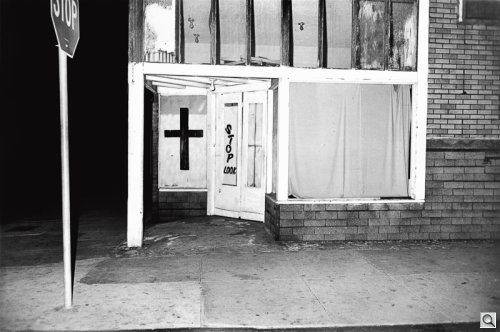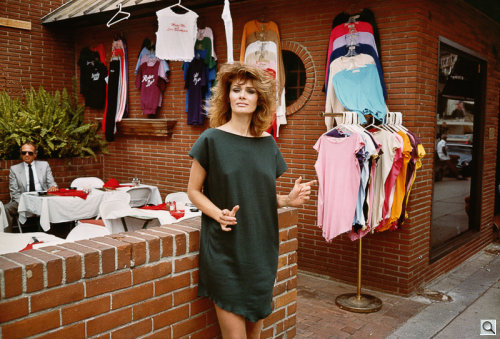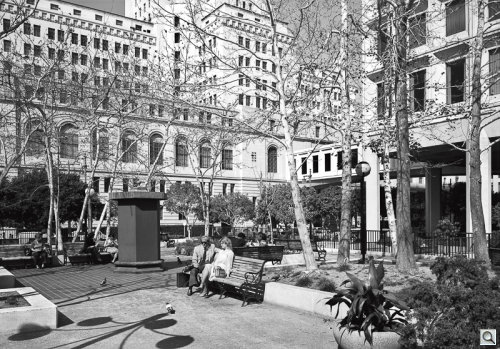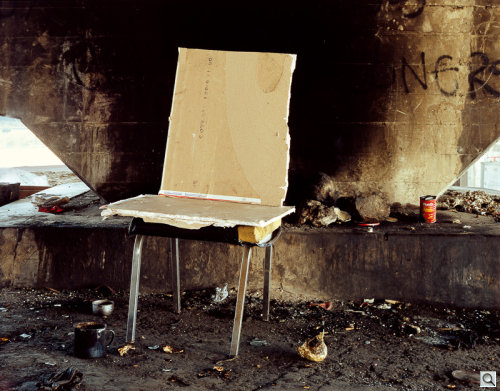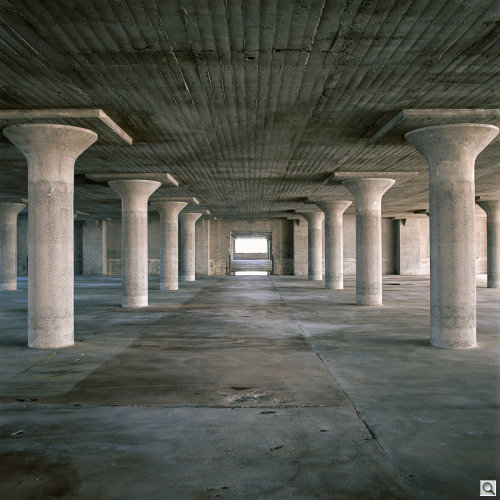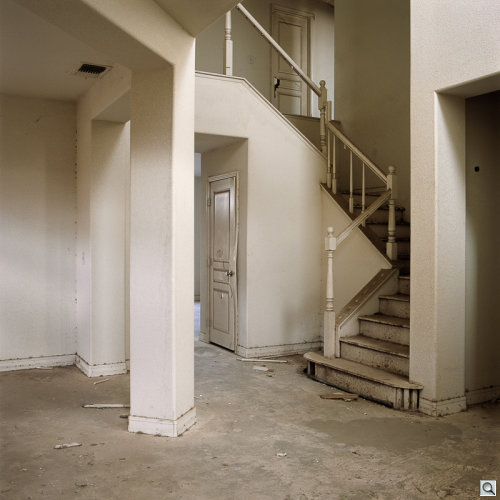Photo Corners headlinesarchivemikepasini.com
![]()
A S C R A P B O O K O F S O L U T I O N S F O R T H E P H O T O G R A P H E R
![]()
Enhancing the enjoyment of taking pictures with news that matters, features that entertain and images that delight. Published frequently.
Anthony Hernandez's SFMOMA Retrospective




28 September 2016
We dropped by SFMOMA the other day for the press preview of Anthony Hernandez's first retrospective. In about 160 photographs it spans over 45 years of his career beginning with his black-and-white Nikon street shots of Los Angeles in the 1960s and continuing to his most recent work.
We recently featured Hernandez in a Saturday matinee just before the retrospective opened. It's a double feature, the first video discussing his recent work and the second showing him photographing in the Mojave. Together they make an excellent introduction to Hernandez's photography.
But there's nothing like the real thing. And that's what we got a chance to see at SFMOMA. Here's our report.
INFLUENCES
From his first images, Hernandez seems to have known that the world would be his studio. He would not be spending his days setting up strobes and backgrounds in a room cluttered with gear but be out in the street, sometimes around people, sometimes around what they had left.
We'll begin our report with a look first at some of his formative influences, including the events that changed his life and the photographers he admired.
His parents were both born in Mexico and had immigrated to Colorado as children. They met in school, married and moved to Salt Lake City. His father served in the U.S. Navy as a guard at a prisoner-of-war camp in Logan, Utah, before the family moved to Los Angeles where Hernandez was born in 1947.
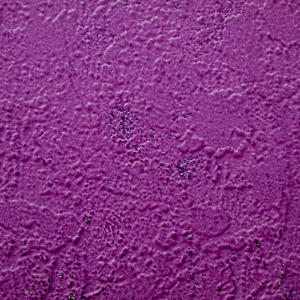
'South Central' Detail. A macro panorama of a painted-over wall.
Hernandez's childhood was spent in Aliso Village along the Los Angeles River and in Boyle Heights, which also overlooks the river. His father worked as a machinist and his mother in a meatpacking plant as the young Hernandez played along the river and in the streets of his neighbhorhood.
When he was nine years old, Hernandez lost his best friend Wayne in a car accident. And three years later, his father died of chirrosis. Both deaths had a profound effect on him.
But the loss of his father also left him free to get into trouble. By the seventh grade, he and his friend Albert had been kicked out of school and were initiated into gang life. But Hernandez, who knew one when he saw one, realized that was a dead end.
In one of those twists of fate that seem only to come out of Hollywood rather than South Central, Hernandez's life changed by accident. Albert had found a basic photography manual published by the Navy discarded in the men's room at East Los Angeles College. He gave it to Hernandez.
As Erin O'Toole tells the story in her excellent essay in the show's catalog:
Hernandez had never shown any interest in photography, so it is unclear what motivated his friend to give him the book. Whatever the impulse behind the gesture, whether it was luck or intuition on Cordova's part, Hernandez says it changed his life. He knew little about photography, but with no plans after graduation, Hernandez thought he might become a fashion photographer. The possibility of meeting young women and making some money in the process was enticing enough, so after high school he lived at home and took darkroom classes at ELAC. It would be his only formal training in the medium and the extent of his postsecondary education.
He won $100 in a newspaper raffle his mother had entered for him and with another $25, he asked a friend's sister, who was a stewardess, to pick up a Nikon for him in Toyko. It was his first 35mm camera.
He would leave that camera with his aunt Dolores for safekeeping when he shipped out as a medic to Vietnam in 1967. She had encouraged his artist inclinations and introduced him to jazz, which he loved. She also bought him a subscription to Artforum when he was overseas. It acquainted him with abstract painting, which had a formative influence later in his career.
But his immediate influences were black-and-white street photographers. He knew what he wanted to shoot -- the streets of Los Angeles -- but it wasn't until he saw the work of Lee Friedlander, Garry Winogrand and Bruce Davidson that he got an idea of how to go about it.
It was the work of Edward Weston, which Hernandez first encountered in college, that took him to a different level. Hernandez did a series of beach shots influenced by Weston's famous photograph of his wife Charis posed naked on the sand. But Hernandez's images were of real people, often elderly, still dressed in their street clothes, sprawled in the sand for a nap.
Hernandez had committed himself to fine art photography at this point and made a trip to New York to show his portfolio during which he not only sold some prints but was persuaded by the photographer Tod Papageorge to buy a Leica if he really wanted to be a street photographer.
That didn't much change his photography, though. Those early black-and-white images exhibit the unlevel horizons and converging verticals of quickly composed, street images.
But looking for more detail, Hernandez moved up to a Deardorff view camera and, while still shooting black-and-white, started straightening his horizons and getting his verticals parallel. It's a striking change in his esthetic that remains embedded in his current images.
He began his work in 35mm shooting ISO 400 Tri-X then the slower, more detailed Plus-X. He moved to 4x5 sheet film and now works in medium format using Fujifilm color film.
Hernandez has had a long relationship with master printer Michael Wilder, who printed his Rodeo Drive Cibrachromes in 1984 and now makes his large inkjet prints.
There's one other important influence and long relationship in Hernandez's life. He has been married to the writer Judith Freeman since 1986.
REMARKS
At the press preview, Neal Benezra, Helen and Charles Schwab director, greeted the audience with a few introductory remarks about the museum's expanded commitment to photography and the retrospective itself.
He also acknowledged Curator Emirita Sandra Phillips, who recently retired, as a very early Hernandez advocate. She did in fact buy his work when no one else was buying it and there are several pieces in the exhibition the artist has promised to her.
Later Benezra wrapped up the session by noting that the trouble with retrospectives is that they usually signal the end of an artist's creative career. Not so in this case, he was happy to report. Hernandez has several new projects in the works.
Baker Street Foundation Associate Curator of Photography Erin O'Toole explained that the show has taken six years to realize. She had become acquainted with his work years ago when she was putting together a survey of Western photographers. And even then she had been surprised that such an accomplished artist had never had a retrospective. Having organized his first retrospective, she said she feels "like I've pretty much won the lottery."
The exhibit, she said, spans work from the late 1960s to last year and shows how Hernandez forces himself out of his comfort zone to try new things. The shifts in his career are consequently the organizing principle of the exhibition.
His subjects have evolved from people on the street, to the urban landscape, to what people have left on that landscape, to interiors, close-ups and long shots of the desert landscape. And his themes have ranged from abandoned places, discarded things, homelessness and overlooked aspects of the urban environment, she said.
She ended her introductory remarks by thanking Curator Emirita Sandra Phillips for the support she's shown both herself and Hernandez, which was echoed immediately by Hernandez.
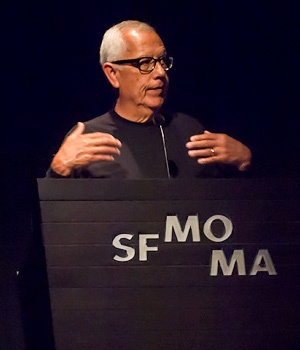
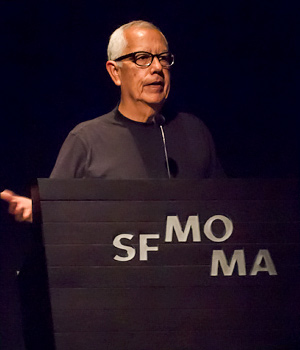
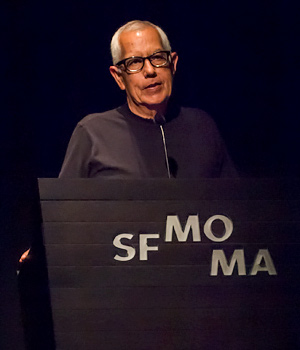
Hernandez said their relationship goes back a long time, which makes him happy because it means that SFMOMA has more of his work than any other museum. It was a lot of work to put the show together, he now realizes, but it reflects his career accurately.
It's a great moment, he said, as he embarks on a new start with new projects.
He introduced both his printer Michael Wilder and Thomas Zander, his dealer from Cologne.
Los Angeles, he said, may be his studio but his studio is getting larger. It now includes California, Nevada and Idaho. Which is really exciting, he said.
He was pleased to see the show begins with his very first picture of a store front church in South Central. That whole area of LA is where he has photographed a lot, he said. He thinks of it, despite its poverty, as a very rich place. Those poor areas of the city have been a gift to him, he added, which he is sharing with us here.
Places like that, which never had people coming in to look at them in a different way, well, "for me that's important," he concluded.
THE EXHIBIT
The exhibit takes over the entire Pritzker Center for Photography in the Snøhetta-designed extension of SFMOMA. It's the first in the museum's more "regular rhythm of exhibitions," as Benezra put it, after the re-opening extravaganza.
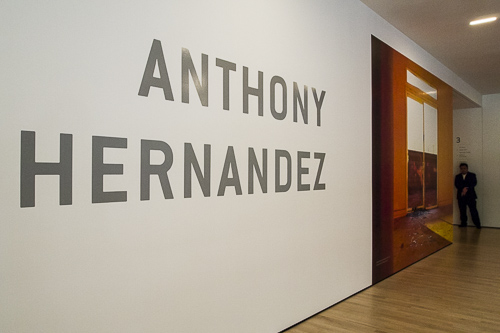
Entrance. Third floor signage for the exhibit.
From very early in his career, Hernandez tended to collect his images into a series of images that share a theme. These themes are really what unifies the images although each series is either all in black and white or in color.
Print size, which gets large early in his career, and aspect ratio, which varies by film format, are not part of the deal, though.
The series, then, in chronological order:
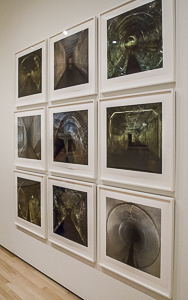
'Everything'. Nine images from the series.
- Automotive Landscapes (1978)
- Public Transit Areas
- Public Fishing Areas
- Publish Use Areas (1982)
- Rodeo Drive (1984), his first color and last figurative work
- Shooting Sites (1986-88)
- Landscapes for the Homeless (1988-1991)
- Pictures for Rome (1998-99)
- Oakland (2000-2001)
- Everything (2002)
- East Baltimore (2006)
- Forever (2007-2012)
- Discarded (2012-2015)
The Cibachromes and inkjet prints have all been printed by Wilder whose "meticulous attention to detail and his fine work contributed so much to the final result," Hernandez acknowledges in the show catalog. And indeed the scans and prints are spectacular for both their resolution and tonal range.
No doubt Wilder's biggest challenge was printing one special image.
Outside the Pritzker Center for Photography exhibit is South Central (2015), a panoramic inkjet mural printed on vinyl made especially for this exhibit and the long wall in the Botta section of the museum on the other side of the cafe.
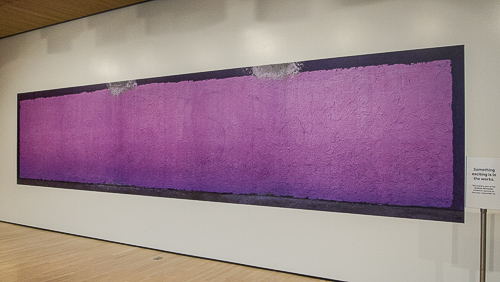
'South Central'. A site-specific photographic mural created for the exhibit.
It's a 25-foot long composite of four 6x7-inch transparencies (not 6x7cm transparencies, we were told when we asked) shot very close to the wall and merged in Photoshop.
While the paint itself is brilliant, it's covers some purple graffiti. The straight-on angle Hernandez took includes the debris from the street at the bottom as well. It's beautiful in an unexpected way.
THE WORK
It's a great temptation to have the artist at hand as you view the exhibit. And Hernandez, who is not a pretentious person, politely answered any question thrown at him.
But the task is to engage with the art, not the artist. We won't always have the artist at our side to explain things. Perhaps more than he should.
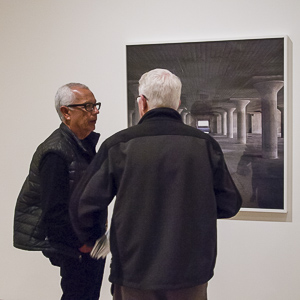
The Artist and the Art. Hernandez discussing 'Oakland #1' from 2000.
And, more importantly, good work stands alone, taking on its own life. You have to look at it.
We took two tours through the exhibit. The first time we just wandered through, reading the section descriptions and enjoying each image at our leisure before moving on. Sometimes we came back to an image. Sometimes we came back to a room, informed by a latter development.
There's no guided tour for viewing an exhibition. You have to go where you will and come back as often as you like.
The second time through we photographed the images we liked the most, the ones that had stuck in our mind. We were old friends now.
Funny thing, though. Our images of Hernandez prints unavoidably reflected us in the glass. We started thinking of this as a sort of play within the play.
Fortunately we were able to get digital files of the images from SFMOMA for this review. Click on the thumbnail for an enlarged image.
So what did we like?
It didn't take us long to find something. Los Angeles (1971), which greets you just as you come into the exhibit, is a series of 12 images all shot from the same vantage point of a doorway, the shutter snapped just as someone opens the door to leave. It's great fun.
Los Angeles #5 (1971) is the store front church in South Central that Hernandez spoke fondly of in his remarks. It's a rich image we greatly enjoyed. One window on the side has a large cross and nothing else, just in case it isn't clear this corner store is a church now. The sign in the glass door says, "Stop, Look." The letters in the word "Stop" cascade down onto the word "Stop." An animated format, in a sense. All reinforced by the Stop sign in the foreground.
A night shot, persumably with Tri-X that Hernandex favored at the time, it required artificial lighting. But the angle of the shadows suggests it wasn't flash (which would probably have been on the camera) but headlights.
Many of those first black-and-white images have people in them but they aren't particularly cooperative people. And at a certain point, it seems Hernandez preferred to train his lens on people who didn't notice either him or anyone else around them.
The Rodeo Drive images were his first use of color but they are of quite different people than those in his black-and-white images. For all their material advantages, they remain distint and inanimate.
We had to examine Rodeo Drive #34 very closely to determine the woman standing near a rack of clothes was not a manikin. And in the background was a man seated at a cafe table who could not have been less interested in the shot.
The Deardorff, as we said, changed things. Among our favorites is Public Use Areas #27, a finely-detailed 28x40-inch inkjet black-and-white print of a downtown public space with office workers taking a break on the benches, pigeons pecking for lunch, nothing posted on the event kiosk, barren trees surrounded by the office buildings and on the beyond the public space you can see people walking on the sidewalks. It's a world of its own.
That brought us to his color work devoid of people. And in that early group, the series that we lingered longest over was Landscapes for the Homeless. Hernandez would visit homeless encampments during the day when the occupants were out, set up his view camera and capture some aspect of their place of rest.
In 1988, these were isolated encampments, not the communities we see today. We were particularly moved by Landscapes for the Homeless #18, which depicts a metal chair, its foam seat and back deteriorated and recovered with two pieces of broken sheet rock.
Between 1998 and 1999 Hernandez was a Rome Prize fellow. During that time, he created a series called Pictures for Rome which echo the abstractions he must have studied in those of Artforum magazines of the 1960s.
The mostly square, symmetrical compositions with saturated color are echoed in later images from Oakland and Baltimore and finally even his return to the Los Angeles River where he played as a boy with his series Everything from 2002.
In describing Everything, M. G. Lord wrote:
"Although Angelenos often pass by the river -- it runs near or beneath several freeways -- few have really seen it, because, Hernandez says, 'You can't see it unless you're physically down there, unless you walk its concrete corridor.'
In Forever Hernandez returns to the homeless encampments but this time he changes perspective. Rather than frame the encampments as still lifes themselves, he sets up in them and turns the camera around to see what the homeless see.
None of that quite prepares you for the last series, Discarded, which runs back down the hallway of the Pritzker Center to the place you began this adventure.
You remember his career in photography began with a discarded manual a friend gave him for no particular reason.
And you see in this latest series his affection for the discarded. You remember the black and white street shots of people not looking at either him or each other. You remember the homeless encampments furnished with discarded items.
But far from the distaste you might feel running into these objects in real life, you feel they have been enobled by the print, in glorious color and larger than life, like Los Angeles itself.
And you remember Hernandez saying how important places like that are to him, places that just don't have people coming to look at them, as if they don't matter. Places that would be discarded if we could discard places. But all we can do is ignore them, like the Los Angeles River.
LEAVING THE EXHIBIT
Leaving the exhibit, it took a few minutes for our eyes to adjust to the bright midday sun of downtown San Francisco. Even in Minna, the alley seemed brighter than the exhibit space.
We didn't have to look where we were going because we'd spent many years working in the neighborhood at a weekly magazine.
But when our eyes did adjust, we saw a new world.
The alley seemed to be posing for us, shiny brass fittings smiling, blown litter leaning up against walls as if they were claiming some turf, discarded cigarette butts sprawled like half-naked models in the gutter.
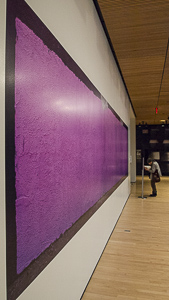
'South Central'. Worth another look.
As we walked up New Montgomery, we passed a public trash can that served as a backrest to a street person hoping to intercept some half-eaten lunch before it was discarded.
Across the street, we saw a vibrant mechanical lift raising workers in unblemished white overalls and brightly colored hard hats work on a window as if they had been hired entertainment.
And as we passed the entrance to the Palace Hotel, the brilliant yellow and green cabs lined up for passengers seemed painted for the occasion.
The world, in short, looking different to us after seeing the Hernandez retrospective.
We were paying more attention on the theory that there's more to things that what immediately meets the eye. Debris in an alley, a panhandler, workers, cabs in front of a hotel. Sure, so what?
But we'd just spent an hour and a half looking at a treasure trove of discarded things. They had no particular intrinsic value, but they had played a role in the landscape, in time. They had mattered.
And because of that, as Hernandez said, they still do matter.
(The Anthony Hernandez Retrospective runs through Jan. 1, 2017 at SFMOMA, Floor 3, Pritzker Center for Photography. The museum is open Friday to Tuesday from 10 a.m. to 5 p.m. and until 9 p.m. on Thursday but closed Wednesday.)
